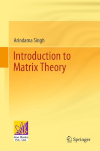- About MAA
- Membership
- MAA Publications
- Periodicals
- Blogs
- MAA Book Series
- MAA Press (an imprint of the AMS)
- MAA Notes
- MAA Reviews
- Mathematical Communication
- Information for Libraries
- Author Resources
- Advertise with MAA
- Meetings
- Competitions
- Programs
- Communities
- MAA Sections
- SIGMAA
- MAA Connect
- Students
- MAA Awards
- Awards Booklets
- Writing Awards
- Teaching Awards
- Service Awards
- Research Awards
- Lecture Awards
- Putnam Competition Individual and Team Winners
- D. E. Shaw Group AMC 8 Awards & Certificates
- Maryam Mirzakhani AMC 10 A Awards & Certificates
- Two Sigma AMC 10 B Awards & Certificates
- Jane Street AMC 12 A Awards & Certificates
- Akamai AMC 12 B Awards & Certificates
- High School Teachers
- News
You are here
Introduction to Matrix Theory

Publisher:
Springer
Publication Date:
2021
Number of Pages:
203
Format:
Hardcover
Price:
99.99
ISBN:
978-3-030-80480-0
Category:
Textbook
[Reviewed by , on ]
Allen Stenger
12/12/2021
This is a concise, concrete introduction to matrix theory and linear algebra, designed as a one-semester course for science and engineering students. Unusually it avoids all applications (p. v: “without any distraction towards applications”). The book is oriented towards the engineering curriculum in India, which typically allows only one semester for linear algebra or matrix theory (p. vi).
This is primarily a matrix book (rather than a linear spaces book), as its title indicates, but it does have several more abstract chapters dealing with vector spaces. Unusually, it has a chapter on matrix norms, including some discussion of the contraction mapping theorem and matrix exponentials. The book has a reasonable number of exercises. These are divided into Exercises, which appear at the end of each section and are numerical drill, and Problems, which appear at the end of each chapter and are more theoretical or open-ended and are aimed at the “curious student” (p. vi). No answers or hints are given for any of the Exercises or Problems. (As far as I can tell, there are no supplements or instructor materials for this book.)
I think the concision of this book, and its omission of all applications (including geometric ones), is a weakness. The book tends toward being a collection of definitions and examples of the definitions, and it doesn’t give a good idea of where the subject is useful. The book spends a lot of time on the numerous canonical forms of matrices, and it’s hard to understand why these particular forms were chosen when we don’t see them used anywhere. This weakness also afflicts the treatment of eigenvectors and eigenvalues, which I consider the central idea of linear algebra, but get short shrift in this book.
Gilbert Strang’s Introduction to Linear Algebra is also a text for a one-semester course. It is also a matrix book, although it views vectors as central: matrix multiplication is a method to form linear combinations of the columns of the matrix. The emphasis on vectors gives the book a strong geometrical view, which is less present in Singh. Chapter 6 on Eigenvalues and Eigenvectors is especially strong and is the “bridge” of the book: tying together what has gone before and pointing the direction for the rest of the book. This book is relatively weak on applications, and they are mostly segregated in the last chapter and so can be omitted if desired.
David C. Lay et al.’s Linear Algebra and its Applications is also a text for a one-semester course, although it has much more material than will fit in one semester and the instructor is expected to select a subset based on the focus of the course. The starting point for this book is systems of linear equations, and this influences the direction of the rest of the book. This book is very strong on applications and they are interleaved everywhere with the theory.
Allen Stenger is a math hobbyist and retired software developer. He was Number Theory Editor of the Missouri Journal of Mathematical Sciences from 2010 through 2021. His personal web site is allenstenger.com. His mathematical interests are number theory and classical analysis.
See the publisher's website.
- Log in to post comments




